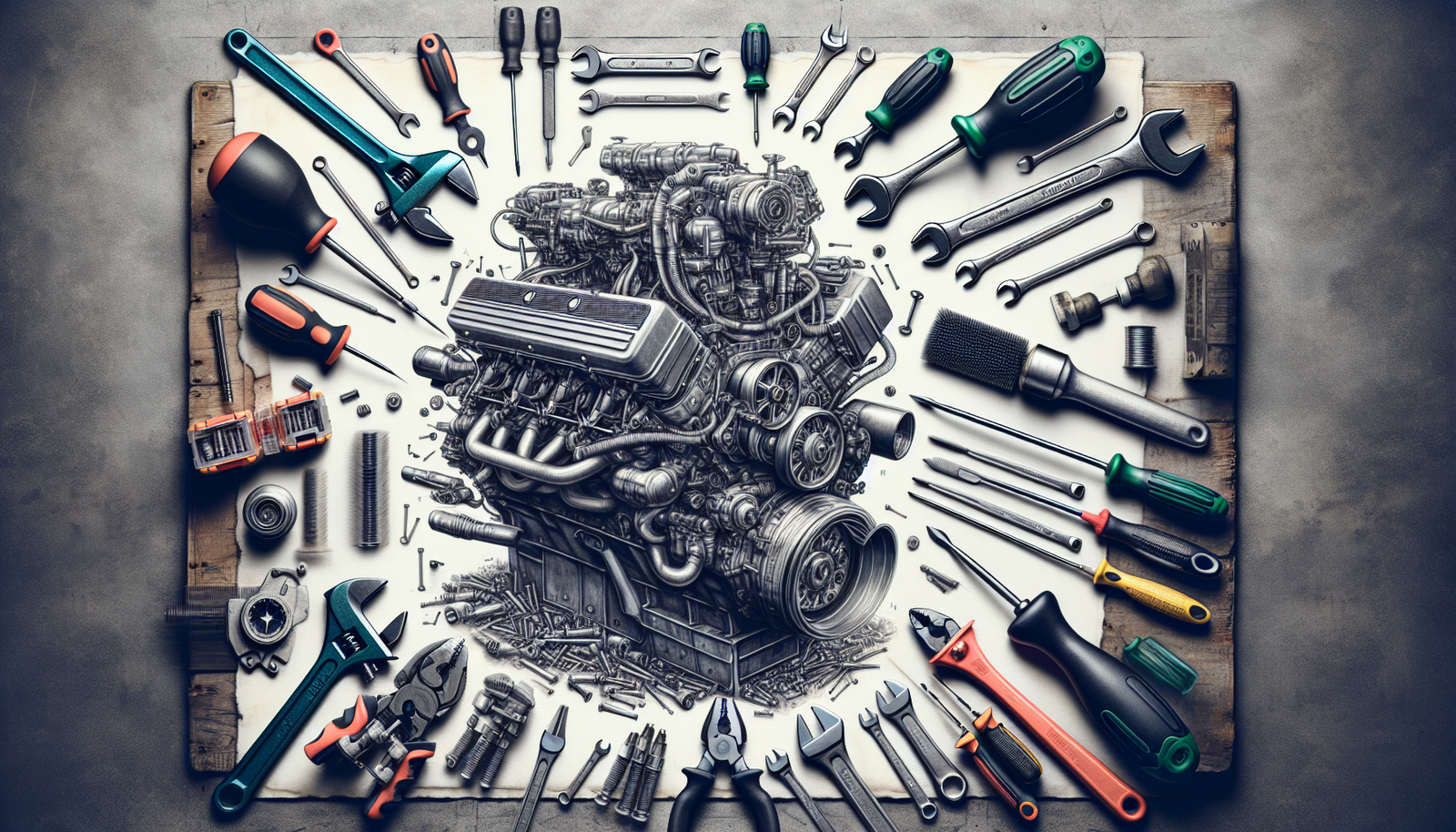Picture this scene: You are out on a crystal-clear lake, miles from any kind of help. Your fishing rod is quivering with the catch of a lifetime… and then, your engine sputters and falls silent. Wouldn’t you want to be well-prepared to deal with such a situation? “Essential Tools For DIY fishing boat engine Repairs” is about precisely that. A handy guide, packed to the gills with expert insights to arm you with everything you need to tackle unexpected engine problems on your own. After reading this, you’ll not just be better equipped but also confident to face and solve any engine issues swing your way.

Understanding Your Fishing Boat Engine
Knowing your way around your fishing boat engine is the first step to maintaining it and ensuring it runs efficiently. Here’s everything you need to know.
Anatomy of a Fishing Boat Engine
Like a heart in a body, the engine is the power center of your fishing boat. Its anatomy consists of several critical parts, including the cylinder heads, pistons, camshaft, valves, and fuel injectors, among others. Understanding their functions and how they interrelate can help you diagnose and resolve minor issues. And you’ll appreciate the beast that powers your aquatic adventures, too.
Engine Types: Outboard vs. Inboard
One of the basic distinctions in boat engines is between outboard and inboard types. Outboard engines, the most common type, are mounted on the boat’s rear and combine the engine, gearbox, and propeller in one unit. They are user-friendly, easier to maintain, and perfect for small to midsize boats. Inboard engines, on the other hand, have a separate gearbox and sit inside the boat. They are ideal for larger boats due to their higher power and are more stable and quieter but require more technical know-how to maintain.
Understanding Engine Specifications
Engine specifications such as horsepower (HP), engine displacement, RPM (Revolutions per Minute), and fuel type are essential to grasp. Understanding these specs can help in the selection and maintenance of the engine, ensuring it is suitable for the boat size, load, and type of use.
Maintaining Your Engine’s Health
Just like maintaining your health helps you function optimally, the same applies to your boat’s engine. Here’s why and how.
Importance of Regular Maintenance
Regular maintenance extends the life of your boat engine, enhances its performance, and prevents breakdowns that can disrupt your fishing trips or even put your safety at risk. It involves regular check-ups and replacing worn-out parts before they cause problems.
Common Signs of Engine Trouble
Keep an eye out for common symptoms of engine trouble, such as difficulty starting the engine, misfires, rough idle, oil leaks, or overheating. Also, sudden changes in fuel consumption, unusual noises, or excessive smoke can be warning signs. Early detection of these signs can save you from costly repairs or replacements later.
Routine Check-up to Keep a Healthy Engine
Regular oil changes, checking the spark plugs, cleaning or replacing air filters, and flushing the cooling system are some routine check-ups you can do to ensure a healthy engine. Remember, a well-maintained engine is not just more reliable but also more efficient, meaning more fish for your effort.
Basic Tools for DIY Fishing Boat Engine Repairs
Having a set of basic tools can make DIY maintenance and repairs a snap. Here are a few must-haves.
Socket Wrench Set
A socket wrench set is versatile and ideal for tightening or loosening nuts and bolts in your engine.
Screwdrivers
A variety of screwdrivers, both flathead and Phillips, are essential for jobs like removing screws from engine covers.
Pliers
You’ll need pliers to grip, bend, or cut wires and other small parts during your repair work.
Spark Plug Wrench
If you’re checking or replacing spark plugs, a spark plug wrench is your best friend.
Hammer and Mallet
A hammer and a rubber mallet are useful for tasks that require force, like loosening stubborn parts or fixing dents.
Advance Tools for DIY Fishing Boat Engine Repairs
Some engine repairs may need more specialized tools. Here are some of them.
Compression Tester
A compression tester helps assess the health of your engine by measuring the cylinder compression.
Carburetor Adjuster
To keep the fuel-air mixture in your engine optimal, a carburetor adjuster tool is a must.
Timing Light
To ensure your engine’s firing sequence is as per specifications, you need a timing light.
Engine Hoist
An engine hoist is needed for removing or installing heavy, inboard engines.
Bearing Puller Tools
These tools are essential for removing worn or damaged bearings, which are integral to reducing friction in your boat engine’s many moving parts.

Understanding Fuel System Repairs
Fuel system issues can impact your boat engine’s performance significantly. Here’s how to address them.
Replacement of Fuel Filters
Dirty or clogged fuel filters reduce engine efficiency. Learn how to replace them regularly to ensure clean fuel supply to your engine.
Repairing or Replacing a Fuel Pump
A faulty fuel pump can affect the fuel supply to the engine, causing several issues. Understanding how to repair or replace it can save you downtime.
Dealing with Fuel Injectors
Fuel injectors control the amount of fuel released into the engine. Keeping them clean and properly functional is fundamental to your engine’s health.
Electrical System Repairs
Electrical system issues can seem daunting, but understanding the basics can help you tackle common problems effectively.
Multimeter for Diagnosing Electrical Issues
A multimeter is crucial for diagnosing electrical system problems. It measures voltage, current, and resistance, helping detect issues like shorts and incorrect voltage.
Dealing with Battery and Ignition Systems
The battery powers the ignition system, which in turn starts your engine. Knowing how to check and maintain both is vital for a smooth start and efficient running of your boat’s engine.
Replacing Spark Plugs and Wires
Over time, spark plugs and wires might need replacement due to wear. Make sure they’re in good condition to ensure optimal engine performance.
Propeller and Drive System Repairs
Your boat’s movement depends on the propeller and drive system. Keep them in top condition with these tips.
Prop Wrench for Changing Propellers
A prop wrench is essential for changing propellers. Ensuring your propellers are in good shape is crucial for efficient movement and fuel consumption.
Repair or Replace Propeller Shafts
A bent or damaged propeller shaft can affect your boat’s movement and efficiency. Learn how to repair it or know when to replace it.
Handling Gearbox Issues
The gearbox connects the engine to the propeller. Any issues here can disrupt your boat’s movement, so understanding how to handle them is key.
Cooling and Exhaust System Repairs
Keeping your engine cool and the exhaust system functioning properly is crucial. Here’s why and how.
Replacing a Thermostat
A working thermostat is key to regulating the engine’s temperature. Know when and how to replace it.
Dealing with Water Pumps and Coolant
The water pump circulates coolant to keep the engine cool. Learn how to maintain the pump and replace the coolant when necessary.
Repairing Exhaust Manifolds
The exhaust manifold directs engine gases out of the boat. Keeping it in top shape ensures your engine’s clean and efficient operation.
Safety Precautions When Performing DIY Repairs
As with any DIY task, safety should be your topmost priority while repairing your fishing boat engine.
Always De-energize the System before Working
Working on a live system can be dangerous. Always disconnect the power source and de-energize the system before starting work.
Properly Dispose of Engine Fluids
Always follow local regulations to properly dispose of engine fluids. They’re dangerous to the environment and, in some cases, flammable too.
Use Safety Goggles and Gloves
Always use safety goggles and gloves to protect yourself from accidental splashes and sharp or hot objects.
When to Call a Professional Marine Mechanic
While DIY repairs can be rewarding, there are times when it’s best to turn to a professional mechanic.
Recognizing the Limit of DIY Repairs
If you’re dealing with complex issues or ones beyond your skill level, it’s best to seek professional help. Avoid causing further damage that could increase repair costs or jeopardize your safety.
Keeping Up with Latest Engine Technology
As boat engine technology evolves, so do their repair techniques. A professional marine mechanic has the necessary training and tools to deal with these advancements.
Ensuring Warranty Compliance
Often, DIY repairs may void your engine’s warranty. If your engine is still under warranty, always choose professional repair services to maintain warranty compliance.
With this guide, you’re well on your way to know everything about maintaining your fishing boat’s engine health. With the right tools and knowledge, you can perform basic tasks and emergency repairs effectively. Remember, when in doubt or dealing with complex issues, always turn to a professional marine mechanic to avoid any damage to your boat or engine. Enjoy smooth sailing and happy fishing!


[…] their hands dirty instead of taking their boat to the mechanic, then knowing the best tools for DIY boat engine maintenance is crucial. This guide will arm you with the knowledge of the most suitable, effective, and […]